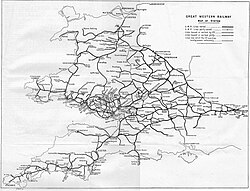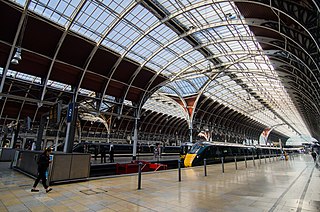
Paddington, also known as London Paddington, is a London railway station and London Underground station complex, located on Praed Street in the Paddington area. The site has been the London terminus of services provided by the Great Western Railway and its successors since 1838. Much of the main line station dates from 1854 and was designed by Isambard Kingdom Brunel. As of the 2022–23 Office of Rail & Road Statistics, it is the second busiest station in the United Kingdom, after London Liverpool Street, with 59.2 million entries and exits.

Heathrow Express is a high-frequency airport rail link operating between London Heathrow Airport and London Paddington. Opened in 1998, trains run non-stop, with a journey time of 15 minutes. The service is operated jointly by Great Western Railway and Heathrow Express Operating Company, a wholly owned subsidiary of Heathrow Airport Holdings. Around 16,000 passengers use the service each day.

The Great Western Main Line (GWML) is a main line railway in England that runs westwards from London Paddington to Bristol Temple Meads. It connects to other main lines such as those from Reading to Penzance and Swindon to Swansea. The GWML is presently a part of the national rail system managed by Network Rail while the majority of passenger services upon it are provided by the current Great Western Railway franchise.

First Greater Western, trading as Great Western Railway (GWR), is a British train operating company owned by FirstGroup that provides services in the Greater Western franchise area. It manages 197 stations and its trains call at over 270. GWR operates long-distance inter-city services along the Great Western Main Line to and from the West of England and South Wales, inter-city services from London to the West Country via the Reading–Taunton line, and the Night Riviera sleeper service between London and Penzance. It provides outer-suburban services in West London; commuter services from its London terminus at London Paddington to the Thames Valley region, including parts of Berkshire and Buckinghamshire, and Oxfordshire; and regional services throughout the West of England and South Wales to the South coast of England. Great Western Railway also operates the Heathrow Express service.

Royal Oak is a station of the London Underground, on the Hammersmith & City and Circle lines, between Westbourne Park and Paddington stations. The station is on Lord Hill's Bridge and is in Travelcard Zone 2 for the London Underground. Although not heavily used at other times, the station is extremely busy during the annual Notting Hill Carnival. There is no wheelchair access to the platform. It is classed as a "local station" in Transport for London's "Fit for the Future" development outline.
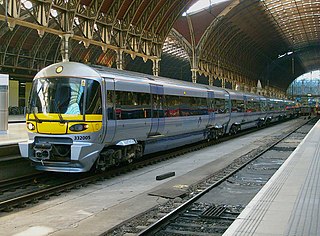
The British Rail Class 332 was a type of electric multiple unit passenger train built between 1997 and 1998 by CAF, with traction equipment supplied by Siemens Transportation Systems. Fourteen units were built for dedicated use on Heathrow Express services between London Paddington and Heathrow Airport.

North Pole depot is a railway and maintenance depot built for Great Western Railway's AT300 units from the Hitachi A-train family. Located in the London Borough of Hammersmith and Fulham, the depot was partially redeveloped by Agility Trains from 2013 as a maintenance site when they were awarded the Intercity Express Programme.

The Night Riviera is a sleeper train operated by Great Western Railway (GWR). It is one of only two sleeper services on the railway in the United Kingdom. The Night Riviera runs six nights a week (Sunday–Friday) between London Paddington and Penzance with one train in each direction.
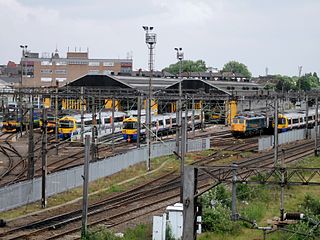
Willesden Traction Maintenance Depot (TMD) is a railway locomotive and electric multiple unit traction maintenance depot, situated in Harlesden, north London. The depot is situated next to the West Coast Main Line, to the south-east of Willesden Junction station and on the way into London Euston station. The depot code is WN.

Laira Traction and Rolling Stock Maintenance Depot is a railway traction maintenance depot situated in Plymouth, Devon, England. The depot is operated by Great Western Railway (GWR) and is where their fleet of Class 802 InterCity Express Trains and remaining Castle Class trains are overhauled. Other trains visit for daily servicing including some operated by CrossCountry.
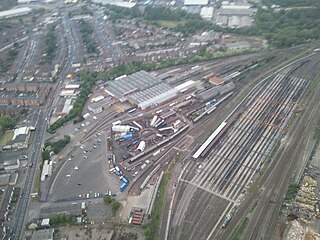
Tyseley TMD is a railway traction maintenance depot situated in Tyseley, Birmingham, England.
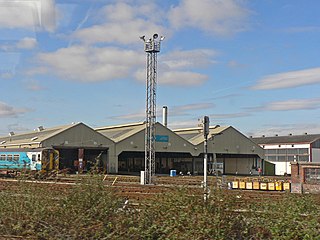
Cardiff Canton TMD is a diesel locomotive traction maintenance depot in Cardiff, Wales. Its depot code is CF. It is operated by Transport for Wales. The depot is used by Transport for Wales fleet and some Cross Country Class 170s.

Penzance TMD, also known as Long Rock TMD, is a railway traction maintenance depot situated in the village of Long Rock east of Penzance, Cornwall, England, and is the most westerly and southerly rail depot in the country. The depot operator is Great Western Railway. The depot code is PZ.

Southall Railway Centre is a non-publicised railway heritage centre at Southall in west London, near Southall railway station and the Grand Union Canal. Formerly of the Great Western Railway, the site is now run partly by Locomotive Services and West Coast Railways, both of whom lease the site from Network Rail. The location is not open to the public.

Stratford TMD was a traction maintenance depot located in Stratford, London, England, close to the Great Eastern Main Line. It was located just west of Stratford station, on a site now occupied by Stratford International station. The depot was, at one time, the biggest on the London and North Eastern Railway with locomotives covering duties from express services to freight workings in London's docks.

The Acton–Northolt line (ANL), otherwise known as the New North Main Line (NNML), is a railway line in West London, England. Built between 1903 and 1906, it runs from the Great Western Main Line at Old Oak Common TMD to the Chiltern Main Line at South Ruislip, alongside the West Ruislip branch of the London Underground Central line, for a distance of around 11 miles (18 km).

Shrewsbury TMD is a railway traction maintenance depot (TMD) situated in Coleham, Shrewsbury, England. The TMD forms part of Coleham Depot, a permanent way depot operated by Network Rail. The code for the TMD is 'SB'.

St Philip's Marsh depot is a railway depot located in the St Philip's Marsh district of Bristol, England. It was established as a steam locomotive shed in 1910 but this facility closed in the 1960s. A new diesel facility opened nearby at Marsh Junction in 1959. This has since been combined with a new shed which was opened in 1976 to maintain new InterCity 125 trainsets.
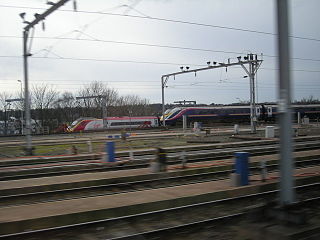
Oxley Traction and Rolling Stock Maintenance Depot is a railway depot located in Wolverhampton, West Midlands, operated by Alstom to maintain Avanti West Coast's British Rail Class 390 Pendolino stock for the West Coast Main Line.

Doncaster Carr rail depot is a railway vehicle maintenance depot located alongside the East Coast Main Line in Doncaster, England. It is presently operated by Hitachi as part of their contract to maintain the AT300 units for London North Eastern Railway and TransPennine Express.






























